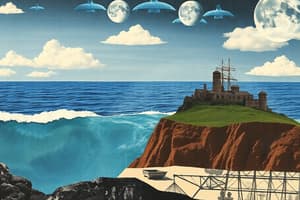Podcast
Questions and Answers
What percentage of the Earth's water is found in oceans?
What percentage of the Earth's water is found in oceans?
- 97% (correct)
- 1%
- 2%
- 71%
What is the turnover time for water in the atmosphere?
What is the turnover time for water in the atmosphere?
- 9 days (correct)
- 12-20 days
- 3,100 years
- 72 hours
In which ecosystem would you find flowing water as a defining characteristic?
In which ecosystem would you find flowing water as a defining characteristic?
- Estuarine Ecosystems
- Lotic Ecosystems (correct)
- Lentic Ecosystems
- Marine Ecosystems
Which zone in marine shores is covered by water during all tides?
Which zone in marine shores is covered by water during all tides?
Which type of reef is built up from submerged ocean islands?
Which type of reef is built up from submerged ocean islands?
What are salt marshes and mangrove forests primarily influenced by?
What are salt marshes and mangrove forests primarily influenced by?
Where are reefs and kelp beds typically located in relation to sunlight?
Where are reefs and kelp beds typically located in relation to sunlight?
Which freshwater ecosystem is characterized by still water?
Which freshwater ecosystem is characterized by still water?
Flashcards are hidden until you start studying
Study Notes
The Hydrologic Cycle
- Over 71% of Earth's surface is water; oceans make up 97%.
- Polar ice caps and glaciers account for 2% of water.
- Freshwater (lakes, streams, groundwater) constitutes less than 1%.
- Water distribution is dynamic, influenced by heat, evaporation, clouds, and precipitation.
- Turnover time varies by reservoir: atmosphere (9 days), rivers (12-20 days), oceans (3,100 years).
Freshwater Ecosystems
- Lotic ecosystems (rivers and streams) feature flowing water and heightened interaction with terrestrial habitats.
- Lentic ecosystems (lakes and ponds) are characterized by still water and significant seasonal changes.
Marine Ecosystems
- Marine Shores: Include the intertidal zone and coastal wetlands.
- Shallow Marine Waters: Home to reefs and kelp beds, requiring sufficient light for photosynthesis.
- Open Ocean: Divided into photic (light-penetrated) and aphotic zones (no light).
Intertidal Zone
- Divided into vertical zones:
- Supratidal Fringe: Splash zone.
- Upper Intertidal: Covered during highest tides.
- Lower Intertidal: Uncovered during lowest tides.
- Subtidal: Always underwater.
Estuaries, Salt Marshes, and Mangrove Forests
- Estuaries form where rivers meet the sea, working with tides and river flow.
- Salt marshes and mangrove forests are found on low-lying coasts, playing crucial roles in nutrient transport and waste removal.
Shallow Marine Waters
- Reef Categories:
- Fringing Reefs: Near the shore.
- Barrier Reefs: Separate open sea from lagoons.
- Coral Atolls: Formed from submerged islands.
- Kelp Beds mimic terrestrial forests with canopy structures at the surface.
- Both reefs and kelp beds are vital for oxygen delivery, nutrient distribution, and waste removal, marking them as highly productive and diverse ecosystems.
Studying That Suits You
Use AI to generate personalized quizzes and flashcards to suit your learning preferences.




